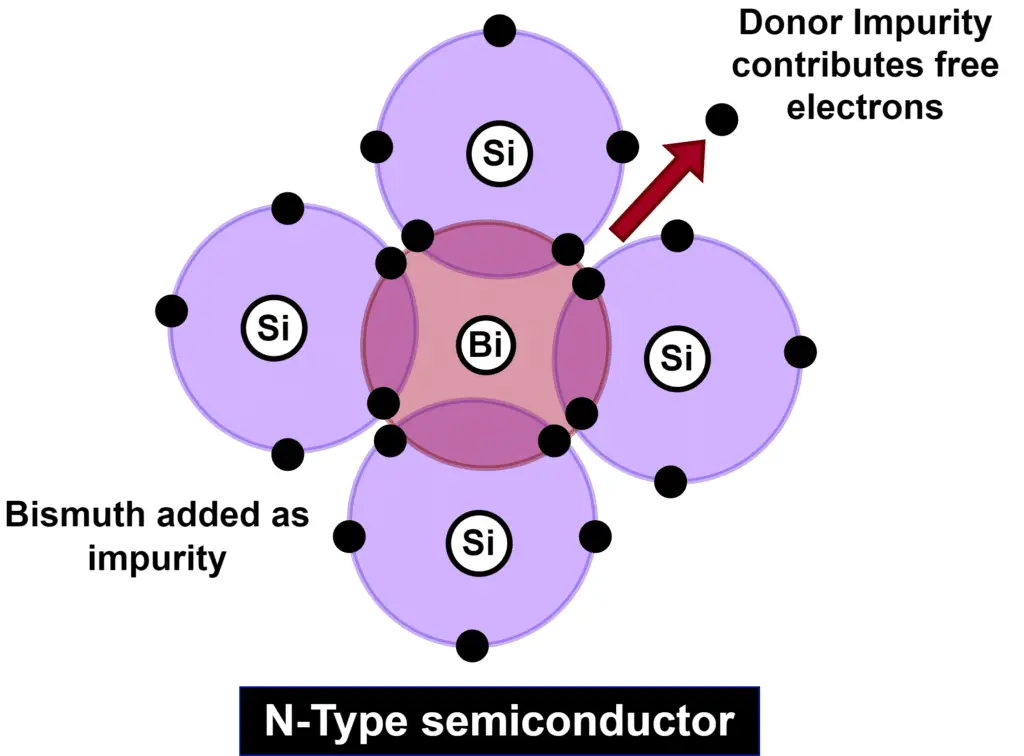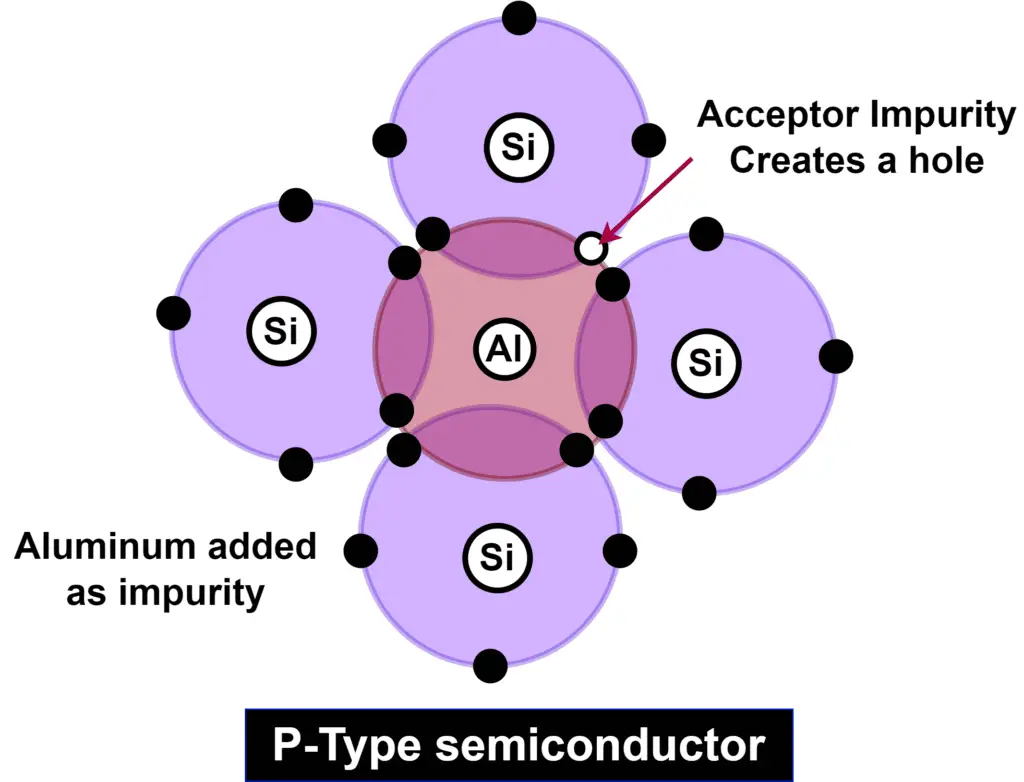The major difference between N-type & P-type semiconductors is that the N-type semiconductor has free electrons as a majority of charge carriers & holes are in the minority. On the other hand, the P-type semiconductor has holes as a majority of charge carriers & electrons are in the minority.
Semiconductors are defined as substances whose conductivity lies between that of an insulator and a conductor. Depending on whether a semiconductor is doped with impurities or not, they are classified into the following two types.
- Intrinsic Semiconductors
- Extrinsic semiconductors
Furthermore, depending on the number of valence electrons present in the doped impurity atom, extrinsic semiconductors are further subdivided into the following two categories –
- N-Type Semiconductors
- P-Type Semiconductors
In this article, we will focus on the important differences between the two types of extrinsic semiconductors namely – n-type and p-type semiconductors.
What is an N-Type Semiconductor?
N-Type Semiconductors are a category of extrinsic semiconductor materials in which a natural form of intrinsic semiconductor such as Silicon, with 4 valence electrons, is doped with pentavalent elements such as Arsenic (As), Bismuth (Bi), etc., having five valence electrons.

The four valence electrons of tetravalent Silicon form a strong covalent bond with that of the four out of the five valence electrons of the pentavalent atom impurity, resulting in the release of one free electron by each impurity atom that is doped with the pure intrinsic semiconductor. These free electrons result in the semiconductor being rich in negatively charged freely moving electrons, responsible for the increased conductivity of the semiconductor material.
Furthermore, an increase in the temperatures would result in an increase in the conductivity of the n-type semiconductor material. Due to the ability of the pentavalent impurity atoms to generate or donate free electrons, n-type semiconductors are also referred to as ‘donor impurity atoms.
What is a P-Type Semiconductor?
P-type semiconductors are also a type of extrinsic semiconductor material in which a pure natural form of intrinsic semiconductors such as Germanium or silicon (having 4 valence electrons) is mixed with trivalent elements such as Aluminium (Al) having three valence electrons.

The four valence electrons of tetravalent Germanium form a strong covalent bond with that of three out of the three valence electrons of Aluminium, resulting in the release formation of a hole. These free holes result in the semiconductor being rich in positively charged freely moving holes, which are responsible for the increased conductivity of the semiconductor material.
Furthermore, an increase in the temperatures would result in an increase in the conductivity of the p-type semiconductor material. Due to the ability of the pentavalent impurity atoms to generate or donate free electrons, n-type semiconductors are also referred to as ‘acceptor impurity atoms’.
Difference Between N-Type and P-Type Semiconductor
The following are the important differences between N-type and P-type semiconductors-
| Parameter | N-Type Semiconductor | P-Type Semiconductor |
| Description | An N-type semiconductor is a type of extrinsic semiconductor in which a tetravalent intrinsic semiconductor is doped with pentavalent impurity atoms to generate free-moving electrons. | A P-type semiconductor is a type of extrinsic semiconductor in which a tetravalent intrinsic semiconductor is doped with trivalent impurity atoms to generate free-moving holes. |
| Kind of impurity atom | The pentavalent impurity atoms that are doped to form n-type semiconductors are – aluminum, gallium, indium, etc. | The trivalent impurity atoms that are doped to form p-type semiconductors are – phosphorous, arsenic, bismuth, etc. |
| Free electrons or holes | N-type semiconductors generate free valence electrons. | P-type semiconductors generate free valence holes. |
| Alternative name | The other name for n-type semiconductors is referred to as donor impurity atoms. | The other name for p-type semiconductors is referred to as acceptor impurity atoms. |
| Majority carriers | The electron density is higher in the case of n-type semiconductors. | The hole density is higher in the case of p-type semiconductors. |
| Minority carriers | The holes are less in number and density in n-type semiconductors. | The electrons are less in number and density in n-type semiconductors. |
| Density of holes and electrons | The density of electrons is higher in the case of an n-type semiconductor. | The density of holes is higher in the case of an n-type semiconductor. |
| Temperature effect | The n-type semiconductors have increased conductivity at higher temperatures, due to the fact that the release or donation of electrons from covalent bonds becomes easier at increased temperatures. | The p-type semiconductors have increased conductivity at higher temperatures, due to the fact that the release of electrons to form holes from covalent bonds becomes easier at increased temperatures. |
| Vicinity of energy bands | The donor energy level is closer to the conduction band in the case of an n-type semiconductor. | The acceptor energy level is closer to the valence band in the case of a p-type semiconductor. |
| Fermi level | The Fermi level lies between the conduction band and the donor energy level in the case of n-type semiconductors. | The Fermi level lies between the valence band and the acceptor energy level in the case of p-type semiconductors. |
| Electric conductivity | Electric conductivity is possible due to the release of abundant free electrons by the pentavalent-doped impurity atoms. | Electric conductivity is possible due to the formation of abundant free holes by the trivalent doped impurity atoms. |
Conclusion
In conclusion, this article highlights the most prominent differences between the two kinds of extrinsic semiconductors namely: N-type and P-type semiconductors. The major difference between them is that the n-type semiconductors are doped with pentavalent donor impurity atoms, having one extra electron available in its valence band, thus enabling the release of abundant free electrons, and resulting in increased conductivity. On the other hand, p-type semiconductors are doped with trivalent acceptor impurity atoms, that are deficient in one electron, resulting in the abundant generation of holes, leading to increased conductivity, which can further be increased with the rise in temperature.